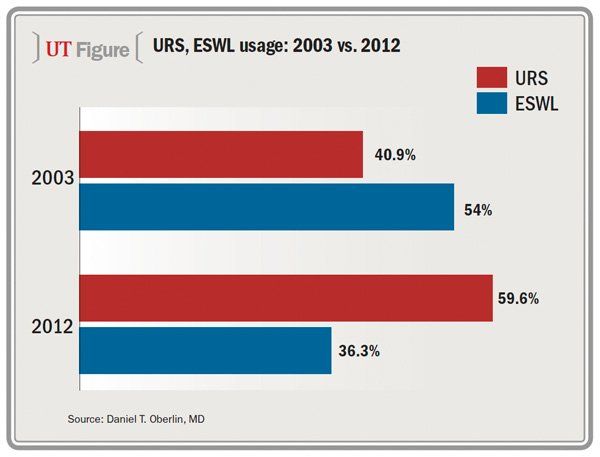Article
Upper tract stone management: URS usage up, ESWL down
Author(s):
A study of contemporary trends in the management of upper tract calculi shows the approach to treatment is influenced by several provider-specific attributes and identifies a steady shift toward increasing use of ureteroscopy.
Editor's note: This article has been updated since its original publication to include additional study data and commentary from the author/presenter.
Orlando, FL-Over the last 10 years, the adoption of endoscopic techniques to manage upper tract calculi has steadily increased to surpass extracorporeal shock wave lithotripsy (ESWL) among newly trained and more experienced urologists across the nation, a study of contemporary management trends shows.
The study also found that the approach to treatment is influenced by several provider-specific attributes.
“Treatment of nephrolithiasis remains a cornerstone in urology practices, and it is important to understand which treatment modalities are being performed by providers in the United States,” said first author Daniel T. Oberlin, MD, urology resident at Northwestern University Feinberg School of Medicine, Chicago.
“It is obvious from the results in our study how the treatment of upper tract calculi has been evolving.”

Continue to the next page for more.
The study, which was presented at the AUA annual meeting in Orlando, FL, analyzed data from case logs submitted to the American Board of Urology for the years 2003 to 2012. CPT codes were searched to identify cases performed using ESWL, ureteroscopy (URS), and percutaneous nephrolithotomy (PCNL). Logistic regression models were used to determine effects of provider-specific attributes, including time in practice (assessed based on whether the case logs were submitted for initial certification, recertification, or second recertification), geographic region, and self-designation as an endourology specialist.

Dr. Oberlin“We felt that the American Board of Urology case logs offered an excellent resource for our study because the logs contain reliable data and provide a broad, nationwide sample of urologists,” said Dr. Oberlin, who worked on the study with Sarah C. Flury, MD, and colleagues.
Data were analyzed for a total of about 441,000 procedures, of which 54.2% were done by URS, 41.3% by ESWL, and 4.5% by PCNL. Over the decade-long study period, the proportion of procedures done by PCNL remained stable, but there was a dramatic increase in the use of URS and a corresponding drop in ESWL procedures. In 2003, URS accounted for 40.9% of procedures while ESWL was used for 54%. By 2012, URS accounted for 59.6% of procedures while use of ESWL had decreased to 36.3%.
URS uptake higher among younger urologists
The patterns were similar in all U.S. regions, and growing use of URS at the cost of a decline in ESWL procedures was observed among urologists in all certification and recertification cohorts. However, compared to the recertification cohorts, new urologists had higher rates of URS use each year and were adopting it at a faster rate. In 2003, URS accounted for 47.6% of procedures performed by urologists seeking initial certification and 41% of those done by more senior clinicians. In 2012, the proportion of procedures performed by the new and senior urologists had risen to 70.9% (+23%) and 55% (+14%), respectively.
Continue to the next page for more.
“Our study confirms previous reports showing that urologists in general and younger urologists in particular are increasingly favoring ureteroscopy over other techniques for treating upper tract calculi,” Dr. Oberlin said. “However, it provides new insight on adoption of ureteroscopy by older urologists, as we show this technique is being increasingly picked up by clinicians who likely were not trained in it during their residency.”
Data on the PCNL procedures showed that it was performed at a significantly higher rate by urologists who were endourology specialists than those who did not identify themselves as such (10.6% vs. 3.7%). In addition, endourologists were significantly less likely than non-endourologists to perform ESWL (34.2% vs. 42.2%).
Dr. Oberlin noted that the study does not provide information for understanding the factors that underlie the observed patterns. For example, it is unknown whether the increase in URS is being driven by patients and/or urologists or whether PCNL is being performed more by endourologists because these cases, which likely involve larger stones, are preferentially referred to endourologists or if endourologists are more comfortable performing PCNL.
“In addition to providing insight on trends in nephrolithiasis management, our study is a foundation for hypothesis generation and future research,” Dr. Oberlin said.UT
Want more stone disease articles? Continue to the next page.
More on stone disease
Stone procedure complications are common, expensive
Study: Keep dietary advice simple for stone patients
Lens design may improve lithotripter performance
Subscribe to Urology Times to get monthly news from the leading news source for urologists.

















